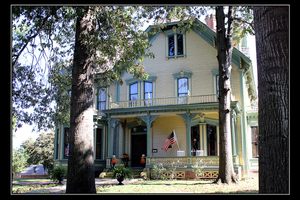About
Built on top of a trailer, this homemade razorback hog has seen better days. It looks as though the structure was once rolled out for parades - and it appears that all four of its legs were once capable of motion - but has since been set out to pasture. The hog can now be found propped up on a cinder block on a chunk of private property so that those driving down the street can see it.
Arkansas was known for its razorback hogs long before the animal because the ferocious mascot of the large public state university - and long before this anonymous fan decided to construct a papier mache monument. These wild boars are known as razorbacks because of the tall knotty strip of hair that runs down their backbone. This animal, which is known for being especially vicious if it feels threatened or is backed into a corner, is not native to the United States, but was brought here by Christopher Columbus (it is believed) way back in 1493.
The then-domesticated animals may have escaped from early settlers and taken up residence in the hills and forests. The wilderness of Arkansas just happens to be perfectly suited to these creatures. Now the product of centuries of breeding between those domesticated swine and the wild cousins in the hills, the razorback can grow to be between four and five feet long; mature males can weigh somewhere between 150 and 300 pounds.
These wild boars are intelligent and fast. They have sharp senses and are very easily irritated. Their only weakness, it is believed, is the heat. They often dig hollows in the mud to cool themselves off during the warmer months.
People tend not to appreciate the wild boars - and not just because they can be terrifying, especially with the long, powerful tusks that males grow. The board also uproot and eat plants and small mammals, destroying vegetation and watering holes wherever they go. Their feeding and constant movement contributes to erosion and, to top it all off, they can transmit diseases to domesticated animals, like dogs. The only people that do like the razorbacks, it seems (well, the real ones, anyway), are hunters.
Related Tags
Know Before You Go
Located on the south side of US 62, on the border between Berryville and Eureka Springs. The hog sits on private property, but is visible from the street.
Published
November 10, 2011
Sources
- The Encyclopedia of Arkansas History & Culture: Razorbacks (Hog): http://www.encyclopediaofarkansas.net/encyclopedia/entry-detail.aspx?entryID=2125
- Places Online: Berryville: Attractions and Travel Guide: http://www.placesonline.com/north_america/united_states/arkansas/berryville/travel_guide.asp
- Agility Nut: Big Critters: http://www.agilitynut.com/critters/pigs.html
- Roadside America: Home-Built Razorback Hog: http://www.roadsideamerica.com/story/14358
- Roadside America: Berryville, Arkansas - Home-Built Razorback Hog: http://www.roadsideamerica.com/tip/7786






















